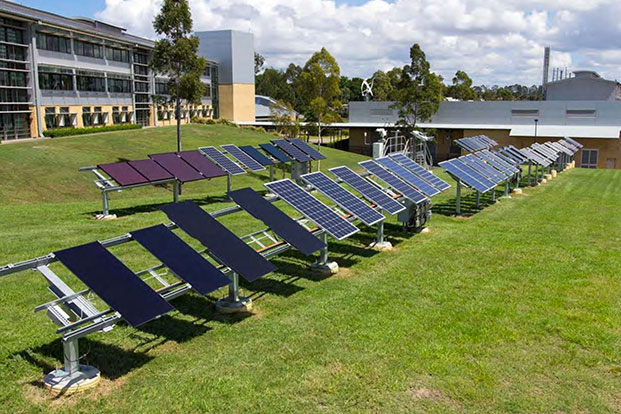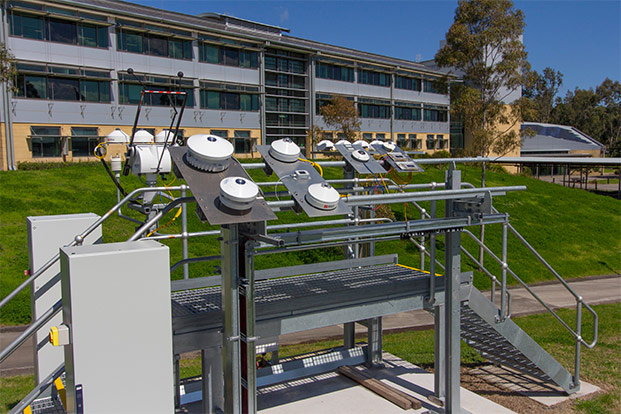Summary
To reduce the investment risk for large-scale photovoltaic power plants, CSIRO and its partners investigated the relationship between the manufacturer’s power rating for solar panels and the energy the panels generate over time.
Key results
The project has demonstrated that careful measurements of four key variables (solar irradiance, module temperature, solar spectrum and solar angle) allows the output to be mathematically corrected back to the standard reference conditions used to nameplate the modules in the factory, provided the sky is clear. The project highlighted the difficulty in accurately predicting PV output during cloudy periods, or for cloudy climates.
CSIRO found that by correcting the output of a PV system back to standard reference conditions you can compare the performance of the system with the rated performance of the installed modules, thus measuring the quality of the system design as well as the health of the system.
CSIRO now have a framework for predicting the impact of solar spectral variations for sites across Australia.
The project partners demonstrated that, with the right measurements, PV system output can be mathematically corrected back to the same standard reference conditions used to nameplate the modules in the factory. This means it is now possible to: (1) Compare the performance of the system with the rated performance of the installed modules, thus measuring the quality of the system design; (2) rapidly anticipate the system output during operation on the electricity grid; and (3) rapidly detect system faults during operation.
The project highlighted the difficulty in accurately predicting PV output during cloudy periods, or for cloudy climates.
Further details of the project outcomes and next steps is available in the report below. A copy of the full project report is available on request.
Learn more
Need
A major obstacle to the implementation of large-scale photovoltaic (PV) power plants is that the cost of these systems is almost entirely up-front, with the financial returns spread over the life of the system, which is around 25 years. Solar panels and systems are rated based on measurements in a laboratory and the power rating says little about the energy the system will deliver over time in the field.
Methods for predicting the output of a PV power plant on both short and long timescales are critical to reducing the cost of new systems and during operation. Accurate output models result in better planning, better design decisions, better yield projections, a faster response to faults and better operation on the electricity grid.
Project innovation
The project included the design and construction of a new facility to study the way solar PV panels respond to changes in the solar conditions, including the irradiance, temperature, spectrum and the sun angle. Software tools were developed and used to analyse data from 59 PV modules from 17 different manufacturers, including 12 different PV technology types.
The project studied the performance of several different mathematical models that make up current best practice for PV energy yield prediction. Two aspects were selected for a deep investigation: (1) the impact of variations in solar spectrum across Australia, and (2) the accuracy of equations that translate the output from one set of conditions to another. A draft Australian spectral impact map has been produced. An analytical framework has been developed that carries forward the concept of a new rating scheme for solar panels, where they are labelled for their true outdoor performance, rather than for laboratory measurement that are unlikely to be experienced in the field.
A new low cost, high accuracy method for measuring the area of solar cells was invented as part of the project, along with a new method for accurately controlling the voltage during cell measurements.
The results of the project are contributing to the development of Australian and international standards for predicting the performance of solar PV power systems.
Benefit
The project provides a better understanding of the factors that affect PV output, maximising the cost-effectiveness of PV power plants for Australian conditions and improving the financial proposition for investors in Australian solar energy.
The new infrastructure developed under this project includes unique indoor and outdoor testing capability and is now accessible to Australian PV research and industry under the brand ‘PV Performance Laboratory’. The indoor laboratory has received the internationally recognised IEC 17025 technical competency accreditation and is the first PV laboratory to achieve this in the Southern Hemisphere.
The outcomes of this research form the basis for better PV system designs, a simpler qualification process, smoother operation and more accurate revenue projections, all of which serve to encourage investment and widespread deployment of large-scale PV power stations in Australia.






